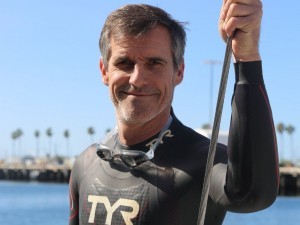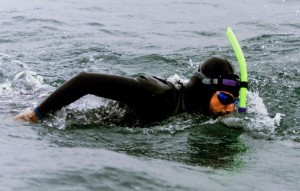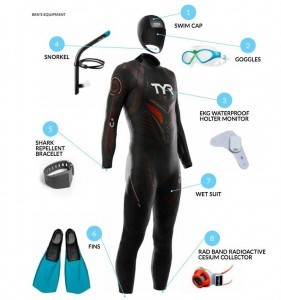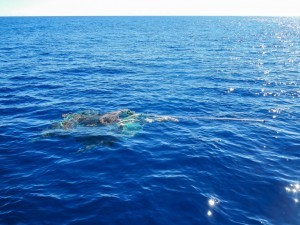If all goes according to plan, Benoît Lecomte should arrive in San Francisco six months from now.
He’s trying to swim across the Pacific Ocean to get there.
Lecomte began his expedition on Tuesday June 5, jumping into the waters off the coast of Choshi, near Tokyo. His journey to the US’s West Coast will require crossing more than 5,500 miles of high seas, encountering marine wildlife including sharks and jellyfish, braving cold temperatures, passing through staggering quantities of plastic, and more.
The first question many might ask him is: Why?
“It’s a very valid question, I am asking myself that question from time to time,” Lecomte told Business Insider. “It started with a passion for the ocean, a passion for ocean water.”
After a 1998 swim across the Atlantic, which took 73 days, Lecomte said the Pacific just seemed like the next thing. Yet time, marriage, children, and various other factors delayed that trip for over a decade. Then about seven years ago, he began focusing on making the journey happen.
Lecomte has partnered with Seeker and Discovery on the project, which they have named “The Swim.” The 51-year-old Frenchman — who lives with his family in Texas when not in the water — hopes the undertaking will help him raise awareness for ocean health, particularly with regard to plastic pollution in the water.
Throughout the entire trip, Lecomte and the boat accompanying him on the journey plan to collect samples and test the water, looking for everything from contamination from the Fukushima incident to the presence of microplastics in the Great Pacific Garbage Patch.
“For me it couldn’t be a better opportunity to get the attention on the ocean and the state of the ocean by doing something crazy like this type of swim,” he said.
8.000 calories a day
During the journey, Lecomte plans to swim for eight hours per day, covering approximately 30 miles with each swim. He’ll spend the rest of the time resting, sleeping, and eating on a boat that will accompany him. The boat will be equipped with a GPS tracker so the crew can monitor where Lecomte exits the water every day and return to that spot for him to resume the next day.
Lecomte will need to eat 8,000 calories a day to power himself through the journey. His meals will mostly consist of freeze-dried foods eaten in several sessions while he’s on the boat, though he’ll consume soup and other liquids while in the water every 30 minutes or so. He said he doesn’t eat sweets but does consume a lot of fat.
For the swim itself, he’ll be equipped with fins, a snorkel, and a wetsuit — which will be extremely necessary once he gets closer to the US, where colder waters could lower his body temperature to dangerous levels.
The Longest Swim
“The most difficult will be the temperature,” Lecomte said.
But the waves, which could be up to 50 feet high, will also pose a serious challenge — especially if they start crashing, which could make it tough for Lecomte to stay near the boat.
Another risk is attention from curious sharks. The boat is equipped with a means of broadcasting an electromagnetic field to keep them from venturing too close and Lecomte will wear a magnetic bracelet that he hopes will ward them off.
“They’ll be there,” Lecomte said of the sharks, noting that the trip passes through an area where great whites are known to migrate. There will also be jellyfish, which he describes as painful, and dolphins, which he describes as “amazing to swim with.”
Getting ready to depart
Lecomte’s physical preparation focused on getting his body accustomed to being active at about 60% of maximum heart rate for a full eight hours. He swam, biked, or ran for three to five hours a day, five or six days per week, and tried to keep his heart rate at 120 for the duration of those workouts. Recently, he was doing six-hour open-water swims.
From a mental perspective, Lecomte said he’d been “working on disassociating my mind from my body.” He hopes that having something to think about and focus on every day will help him cope with the mental challenge of eight hours of swimming at a time.
The trip has been planned in conjunction with various partners, which include 27 scientific organizations like NASA and Woods Hold Oceanographic Institution. Lecomte and the boat crew will collect more than 1,000 samples as they travel, which will allow scientists to learn more about plastic pollution, mammal migrations, extreme endurance, phytoplankton, and other topics.
This isn’t the first time Lecomte has tried to start the cross-Pacific swim — previous attempts have been foiled by issues with boats or crew. But finally, the trip is underway.
Those interested in following Lecomte’s progress can track the journey on Seeker, where there will be live coverage throughout the trip, along with short documentaries every two weeks and a documentary feature planned after the project’s completion.
“The big unknowns are really what will this be like for Ben, and how will this feat weigh on him in ways that we’re not yet predicting … That could be anything from weather just to pure stamina,” Caroline Smith, chief content officer at Seeker, said. “We’re all hoping for the best for him.”
As for Ben, he hopes the trip will inspire people to mobilize around the issue of plastic pollution.
“We each need to take some action to alleviate the problem,” he said. “A single-use plastic is something we can all decide not to use anymore.”
Source: yahoo









